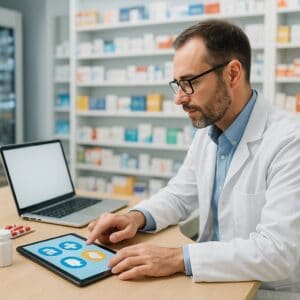Tech News
Bridging Technology and Care: Smarter Solutions for Pharmacies

The digital world is taking over, and no industry is being left untouched. Pharmacies are benefiting from technologies today, and the future looks bright for this sector. Online pharmacy platforms are becoming more popular, as people are gaining confidence in these platforms. They use telehealth services and view online pharmacies as an extension of the services.
While online pharmacies are convenient and easy to access, they must comply with all regulations. Pharmacies must ensure the safety of patients and maintain quality standards. At the same time, consumers want personalized solutions, and many pharmacies use software available from Outcomes to provide these solutions.
Cosmeceuticals
Cosmeceuticals make up a large part of the skincare industry today, and many online pharmacies offer these products to consumers. When active ingredients are added to a skincare product, it becomes a cosmeceutical. The ingredients added to the product may include retinol, antioxidants, vitamins, or marine extracts, among other things. This market is expected to generate $95.75 billion by 2030 thanks to innovations, the discovery of new ingredients that benefit humans, and the prevalence of social media, smartphones, and internet apps.
While this market is growing, there continue to be challenges. Many people prefer to purchase non-specialty drugs at a local retailer rather than through an online or mail-order pharmacy. This is an opportunity online and mail-order pharmacies should consider investing in, as people are searching for customizable healthcare solutions they can easily access. Brick-and-mortar pharmacies also need to find ways to provide these customizable solutions and increase their investment in cosmeceuticals to benefit from this growth.
Artificial Intelligence
Artificial intelligence is currently being used to help diagnose patients and to complete many other tasks in healthcare. It is also being used to help retail pharmacies manage their inventory and ensure they have products on hand when customers need them. This technology predicts medication demand while boosting supply chain efficiency.
Medical Devices
New medical devices are being developed to improve access to healthcare in rural and underserved areas. Augmented and virtual reality devices can be mailed to individuals, who then take pictures of wounds, sores, or rashes. The images are transmitted to a pharmacist, who determines whether an infection is present. If one is, the patient can receive their medications through the mail and treat the infection at home.
Blockchain Technology
Blockchain technology is also being used to increase the efficiency of pharmacies and improve patient care. This technology increases the transparency of supply chains while legitimizing medical commodities. Counterfeit drugs negatively impact many areas, and this technology helps prevent that. Many pharmacies use blockchain technology with patient-centric electronic health records and telemonitoring systems. Platforms using this technology provide comprehensive pharmaceutical services. They increase the accessibility of healthcare while advancing pharmacy services.
Augmented and Virtual Reality
Software is now being used to advance pharmaceutical education and research. Students use virtual and augmented reality technologies to learn pharmaceutical compounding without entering a classroom. This technology increases the accessibility of pharmaceutical training while allowing students to gain hands-on experience.
Healthcare professionals must be able to share patient data and collaborate to improve patient outcomes. One miscommunication can have disastrous results in this industry. Data analytics are being used to provide patients with personalized medicine. Furthermore, they help increase patient engagement and allow individuals to take more control over their health. This patient-centric approach is greatly appreciated, and pharmacists enjoy the latest technology because it allows them to spend more time with patients and less on routine tasks.




